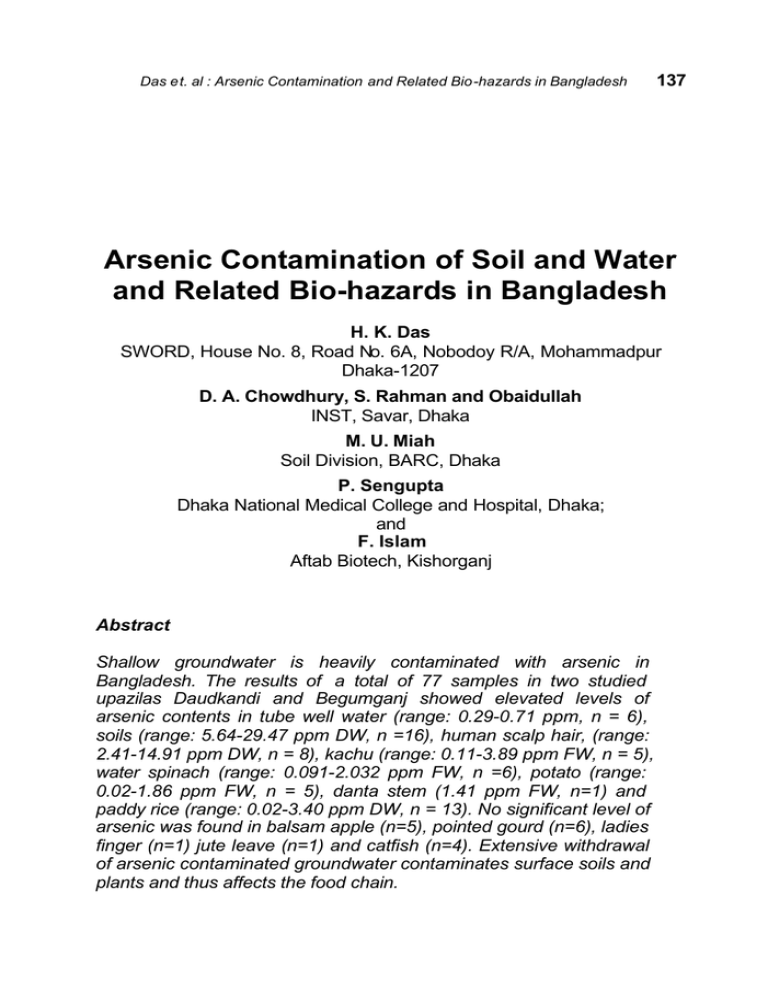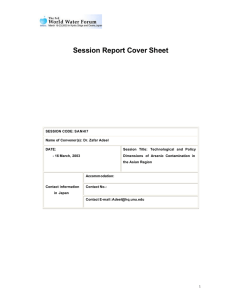Arsenic Contamination of Soil and Water and Related Bio-hazards in Bangladesh
advertisement

Das et. al : Arsenic Contamination and Related Bio-hazards in Bangladesh 137 Arsenic Contamination of Soil and Water and Related Bio-hazards in Bangladesh H. K. Das SWORD, House No. 8, Road No. 6A, Nobodoy R/A, Mohammadpur Dhaka-1207 D. A. Chowdhury, S. Rahman and Obaidullah INST, Savar, Dhaka M. U. Miah Soil Division, BARC, Dhaka P. Sengupta Dhaka National Medical College and Hospital, Dhaka; and F. Islam Aftab Biotech, Kishorganj Abstract Shallow groundwater is heavily contaminated with arsenic in Bangladesh. The results of a total of 77 samples in two studied upazilas Daudkandi and Begumganj showed elevated levels of arsenic contents in tube well water (range: 0.29-0.71 ppm, n = 6), soils (range: 5.64-29.47 ppm DW, n =16), human scalp hair, (range: 2.41-14.91 ppm DW, n = 8), kachu (range: 0.11-3.89 ppm FW, n = 5), water spinach (range: 0.091-2.032 ppm FW, n =6), potato (range: 0.02-1.86 ppm FW, n = 5), danta stem (1.41 ppm FW, n=1) and paddy rice (range: 0.02-3.40 ppm DW, n = 13). No significant level of arsenic was found in balsam apple (n=5), pointed gourd (n=6), ladies finger (n=1) jute leave (n=1) and catfish (n=4). Extensive withdrawal of arsenic contaminated groundwater contaminates surface soils and plants and thus affects the food chain. 138 Fate of Arsenic in the Environment INTRODUCTION Arsenic is ubiquitous in the environment, usually being present in small amounts in all rocks, soils, waters, air and biological tissues (Nriagu and Pacyna, 1988). Elevated concentrations were found in polluted environment (Nriagu, 1990). Shallow ground water in Bangladesh is contaminated with arsenic and the source of contamination is geogenic (DPHE-BGS, 2000). The ground water arsenic contamination causes serious health hazards as reported from many countries of the world, even in our neighboring country India, the people of the province of West Bengal has been suffering seriously from arsenic problem. In Bangladesh, it is reported that about 2 lakhs people are suffering from arsenicosis ranging from melanosis to skin cancer (Das , 2000). Background arsenic concentrations in terrestrial and freshwater biota are usually in ppb level. These levels are generally higher in contaminated areas (Nriagu, 1994). The groundwater in Bangladesh contaminates surface soils and plants thereby arsenic enter the food chain. Arsenic concentration in plants varies from species to species and area to area. The impacts of bio-hazards in Bangladesh have so far yet not been studied. The present study describes the impacts of arsenic contamination of groundwater on rice, vegetables and human scalp hair. MATERIALS AND METHODS Samples were collected randomly from reported arsenic contaminated two upazilas Daukhandi and Bengumganj as per sampling protocol. During sampling data were collected on basic information of arsenic contamination using questionnaire according to specific objectives. Water samples were preserved with 4 ml concentrated HCl per litre and analyzed within 7 days of collection. Crops, vegetables and spinach samples were bagged in polyethylene bags and preserved at + 40C. Fish were rapped with polyethylene and stored at -10°C until analysis. Human scalp hair samples were bagged in polyethylene stored at normal condition. For hair samples both male and female participants were informed fifteen days before the collection. All the subjects who were recruited in the study have been using arsenic contaminated tubewell water for drinking and cooking purposes for many years. Composite soil samples were collected from 0.5-1.5 feet below ground surface. Composite soil samples were dried (108 ºC) in air-circulated oven to obtain constant weight. Crops, vegetables, spinach and fish samples were first washed with de-ionized water in order to remove adhering dust Das et. al : Arsenic Contamination and Related Bio-hazards in Bangladesh 139 and soil particles and air-dried for 3hrs and dried at 108 ºC until a constant weight was obtained. Hair samples were washed first with acetone and then with de-ionized water, air dried and dried in the oven. The dried samples were homogenized and wet digested. Digestion was made by adding perchloric, sulphuric and nitric acid (1.0 ml HClO 4, 1.5 ml H2SO4 and 4.0 ml HNO 3) and heated at (110 -120 ºC) until a clear solution was obtained. The digested samples were then analyzed for total arsenic at the laboratory in the Institute of Nuclear Science and Technology (INST), Atomic Energy Commission, Savar, Dhaka and in Aftaf Biotech, Kishorganj using Atomic Absorption Spectometry (ASS) equipped with hydrous generation. Rigorous quality control procedures were followed throughout the analysis. Replicate measurements, spiking and recovery tests were performed regularly in order to ensure reliable analytical data. Two blank samples were run with each set of samples. Calibration of the machine was made with fresh set of standard solutions 1,2,4,6 or 10 ppb of arsenic. Precision and analytical accuracy of the methods were evaluated by analyzing a standardized reference certified Tomato leaves, SRM-1573 (National Institute of Standard and Technology USA). Inter-calibration was performed, using a certified Tomato leaves-SRM-1573. The certified value was 0.27 + 0.05 ppm; Results of this study provided a mean value of 0.255 + 0.04 ppm DW, with a standard deviation of 24, i.e., 94% of the target value (n = 11). RESULTS AND DISCUSSION Arsenic in Tubewell Water The results of tubewell water showed in Fig. 1. The mean arsenic concentration (0.455ppm) in shallow tubewell (94-163 feet's depth) water was about 10 times higher than the Bangladesh maximum permissible limit of 0.05 ppm. Arsenic content in water samples varied from 0.29 to 0.71 ppm. The highest concentration was found in Dhaudkandi Upazila. It is reported that shallow aquifer layer is contaminated with arsenic in almost all of the districts of Bangladesh (DPHE-BGS, 2000). In this study, elevated level of arsenic in tubewell water was found as the primary source of contamination. Concentration (ppm) 140 Fate of Arsenic in the Environment 0.8 0.7 0.6 0.5 0.4 0.3 0.2 0.1 0 1 2 3 4 5 6 Std Water Samples Figure 1: Comparison of arsenic in water samples Arsenic in Soils The mean arsenic concentration in soils (15.676 ppm) was 1.5 times higher than the worldwide natural concentration of 10 ppm (Berrow and Reaves, 1984). The concentrations varied from 7.21 to 27.58 ppm (Fig. 2). The highest concentration in soil wetted by highest contaminated tubewell water was found in Dhaudkandi upazila. Other than the human consumption, the contaminated water comes in direct contact with the adjacent surface soil, providing a good indicator of pollution status in the affected areas. The arsenic concentration at which rice yield is decreased by 10% is judged to be the maximum allowable limit or critical content of arsenic in soil (Yan-Chu, 1994). Rice decreased by 10% at 25 of arsenic in soil (Nriagu, 1994). In this study, three samples in Daudkandi upazila showed arsenic content (ranged 25.14 to 27.58 ppm) above the critical level set by Japan. The critical arsenic content in soils depends on soil types. Arsenic in Human Scalp Hair Human scalp hair was sampled as the main indicator of intake and consumption of arsenic in humans. Mean arsenic concentration in human scalp hair (8.13 ppm) was more than 4 times higher than the proposed NRCC (National Research Council of Canada, 1978) critical concentration of 2ppm (Fig. 3). Das et. al : Arsenic Contamination and Related Bio-hazards in Bangladesh 141 Concentration (ppm) 35 30 25 20 15 10 5 0 1 2 3 4 5 6 7 8 9 10 11 12 13 14 15 16 Std Soil Samples Concentration (ppm) Figure 2: Comparison of arsenic in soil samples 16 14 12 10 8 6 4 2 0 1 2 3 4 5 6 7 8 Std Hair Samples Figure 3: Comparison of arsenic in hair Long-time intake of inorganic arsenic is known to induce a build-up in the ectodermic tissues like hair and nails (Eisler, 1994). It could be assumed that higher values of arsenic in hair samples were due to longtime accumulation of arsenic through contaminated drinking water sources. Arsenic in Paddy-rice In order to assess the spread of arsenic from ground water to the biota, some common crops and vegetables grown in the studied areas were analyzed for their arsenic content. Paddy is the most important amongst the crops grown in Bangladesh. Paddy grown on the soils adjacent to contaminated water source is analyzed for total arsenic. Arsenic 142 Fate of Arsenic in the Environment concentrations in root, shoot and rice-grain of studied paddy (Oryza sativa) were different. Roots of paddy accumulated the highest concentration followed by shoot and rice-grain (Fig. 4). The mean arsenic concentration in rice-grain (0.23 ppm) is 6 times less than shoot and 10 times less than the root. Figure 4: Arsenic contents in different parts of paddy plant Arsenic in Vegetables and Spinach In an attempt to assess the extent of diversification of the ground water arsenic, the levels of arsenic in common vegetables, spinach and fish consumed by man were investigated. Among the vegetables mean arsenic concentrations in potatoes (Solanum tuberosum) and pointed gourd/potals (Trichosanthes dioeca) were 0.598 and 0.10 ppm FW, respectively and were higher than the values for those grown on untreated or uncontaminated soils, as reported in literature (Nriagu, 1994). In spinach, significant levels of arsenic in arum/kachu (Colocasia antiquorum) and water spinach/kalmi sak (Ipomoea reptans) were found (range: 0.11-3.49 ppm FW, n =5) and (range: 0.09-2.03 ppm FW, n =5) respectively. Arsenic concentrations in balsam apple/korola (Momordica charantia), ladies finger/derosh (Hibiscus esculentus), and Jute (Corchorus capsularis) leaves were not significant. Das et. al : Arsenic Contamination and Related Bio-hazards in Bangladesh 143 In this study, it is experimentally proved that tubewell water in the two upazilas is contaminated with arsenic and acts as the primary source of arsenic poisoning among the inhabitants. The results indicate that human population is affected with arsenic locally using the contaminated water for a long time. From that ground water source, topsoils are also locally contaminated with arsenic leading to a significant accumulation in some plants. The Kachu (arum) grown on the soil that was continuously wetted nearby-contaminated tubewell water showed higher levels of arsenic content. The highest levels of arsenic were found in kachu (3.89 ppm FW) and potato (0.07-1.39 ppm FW) from Daudkandi upazila. Reasons may be due to the fact that the Daudkandi sampling areas were highly contaminated zone than Begumganj Kalmi sak were collected from fields that are washed by drainage water coming from the contaminated tubewell. The average arsenic concentration in Kalmi sak was found to be 0.901 ppm FW. The other vegetables analyzed in the study such as, karola (range: 0.02-0.5 ppm FW, n =5), potal (range: 0.02-1.8 ppm FW), derosh (0.02 ppm FW), and jute-leaves (0.02 ppm FW) did not show significant level of arsenic. The higher levels of arsenic were found in one karola and one potal. Reasons could not be identified but these may be due to continuous uptake of contaminated tube well water. Higher level of arsenic was found in single danta (Amaranthus lividus) stem (1.41 ppm FW) but the reason could not be well understood. Arsenic in Fish Collected catfish/ singh machh (range: 0.021-0.043 ppm DW, n =5) from a canal of Begumganj upazila were analyzed. No significant level of arsenic was found in the fish tissues. No significant level of arsenic was found in canal water and sediments from where samples were collected. In general, arsenic concentration varies in different parts of a plant. Distribution of arsenic in stem of potato is higher than leaves; in arum: leaves and stem contains more arsenic than root; in kalmi sak: leaves arsenic > stem; in paddy: root > stem > rice. Although food chain contamination is not firmly established in this study, yet some trend of arsenic contamination through localized groundwater source found in plants could be considered. From this study it can be concluded that shallow groundwater is contaminated with arsenic. Plants accumulated arsenic through the localized contaminated groundwater sources. Population in those areas is being affected through drinking and cooking of the contaminated tubewell water for a long time. The continued use of contaminated groundwater for 144 Fate of Arsenic in the Environment drinking and cooking may give rise to a buildup of the toxin in human food chain. The elevated levels of arsenic in the above compartments reflect the translocation of biodiversity equilibrium. Further countrywide exclusive research is necessary for conclusive remarks. There are some constraints in this research work. At the beginning of the project devastating flood hit the project areas in July - September 2000. During that period major activities could not be followed strictly. Due to time constraints we are unable to compare the seasonal variation of arsenic contents in the studied areas. ACKNOWLEDGEMENT Authors gratefully acknowledge the BARC-World Bank Contact Research Project providing fund for this research work. INST is also gratefully acknowledged for giving laboratory facilities and Tapash Kuman Das is acknowledged for compilation of data. REFERENCES Berrow, M. L. and Reaves, G. A., (1984). In: Proc Intl conf. Environ. Contamination, 333-340. CEP Consultants Ltd. Edinburgh, KU. Das, H. K. 2000. Bangladeshe Arsenic: Bhayabahata O Sambhabbya Protikar. Bangla Academy, Dhaka. Pp. 1-278. DPHE-BGS 2000. Groundwater studies for arsenic contamination in Bangladesh. Department of Public Health and Engineering and British Geological Survey. Pp. 11-49. Eisler, R. 1994. A review of Arsenic Hazards to Plants and Animals with Emphasis on Fishery and Wildlife Resources. In: Arsenic in The Environment. Part II: Human Health and Ecosystem Effects (Ed. J.O. Nriagu). Pp 185-261. John Wiley & Sons, INC. New York. National Research Council of Canada (NRCC) 1978. Effects of arsenic in the Canadian environment. Natl. Res. Counc. Can. Publ. NRCC 15391. Pp. 1-249. Nriagu, J. O. 1994. Arsenic in The Environment. Part I: Cycling and Characterization. John Wiley & Sons, INC. New York. pp. 1-417. Nriagu, J.O. and Azcue J. M. 1990. Food contamination with arsenic in the environment. In: Food Contamination from environmental sources (Ed. J.O. Nriagu and M. S. Simmons) pp. 121-144. John Wiley & Sons, Inc. N. Y. Das et. al : Arsenic Contamination and Related Bio-hazards in Bangladesh 145 Nriagu, J. O. and Pacyna J. M. 1988. Quantitative assessment of worldwide contamination of air, water and soils by trace metals. Nature (London), 333, 134-139. Yan-Chu, H., 1994. Arsenic Distribution in Soils. In: Arsenic in The Environment. Part I: Cycling and Characterization. (Ed. J.O. Nriagu) . pp. 17-51. John Wiley & Sons, INC. New York.







